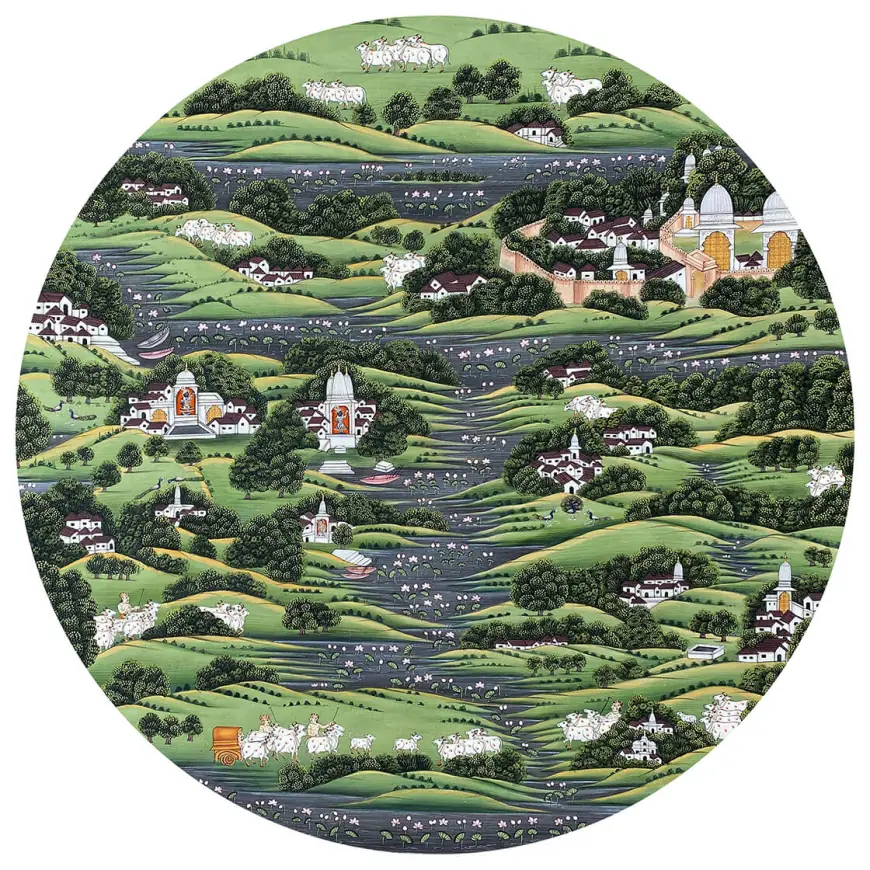Blending Eras: The Rise of Modern Pichwai Painting
Modern Pichwai paintings beautifully bridge tradition and innovation. Rooted in centuries-old devotion from Nathdwara, these artworks now find expression in contemporary forms — soft pastel shades, minimalist compositions, and canvas formats that speak to today’s aesthetics. While the sacred themes of Krishna, cows, and lotuses remain central, their presentation feels fresh and intentional. Thanks to initiatives like Pichwai Art by Pooja Singhal, this once-temple-bound art form now decorates modern homes and global galleries. Each painting invites a moment of stillness, reflecting both heritage and harmony. It’s not just about preserving the past — it’s about letting it breathe anew.

Modern Pichwai Paintings: Where Ancient Devotion Meets Fresh Imagination
I still remember the moment I first saw a modern Pichwai painting. It wasn’t in a temple — it was on someone’s living room wall. I paused. Something about the soft blue background, glowing golden lines, and the figure of Krishna playing his flute — it felt both ancient and new all at once.
That’s what makes Modern Pichwai Paintings so powerful. They carry centuries of sacred devotion, but they don’t demand ritual or tradition to be appreciated anymore.
A New Breath for Old Stories
Traditional Pichwai art comes straight from Nathdwara in Rajasthan. It was born as temple backdrops for Lord Shrinathji and features Krishna scenes, cows, lotuses, and moonlit dances. What’s changed in the modern versions? The core symbols remain exactly the same, but artists play with scale, color, and composition. Think minimalistic backgrounds, pastel palettes, or stylized forms on canvas instead of cloth.
And yet each piece still feels devotional. Every time I look at one, I sense that calm, reverent energy that Pichwai is known for.
The Heart Behind the Revival
What’s helping this art grow beyond temple walls is Pichwai Art by Pooja Singhal. It’s not just a name — it’s a movement. Through this initiative, traditional artisans collaborate with designers to bring Pichwai into contemporary homes and galleries. Traditional motifs remain intact, but the overall presentation feels fresh. That balance of old and new is what makes modern Pichwai paintings feel relevant today.

Why They Matter Now
In a world that’s always rushing, these paintings offer a moment of stillness. The symmetry, the quiet expressions, the lotus blossoms — they invite a gentle pause. Unlike digital prints or fast décor, they feel alive.
Many interior designers now use modern Pichwai paintings to add both a spiritual sense and cultural identity to modern spaces. And people are listening: each piece starts conversations — about faith, heritage, artistry.
Continuity in Creativity
Just because art evolves doesn’t mean its soul should vanish. Today’s modern Pichwai paintings carry forward the same love and reverence that they always carried. But now, they also carry new ideas and fresh aesthetics.
Look closely: you’ll still see Krishna’s flute, the cows, the symbolic moon and lotus. But you’ll also feel movement in the brushstrokes, thoughtful use of space, and colors that resonate with contemporary life. It’s a living tradition — and it’s not stuck in time.
Why I Admire Them
For me, these paintings are a bridge. A bridge between devotion and design. Between yesterday’s rituals and today’s creativity. They remind me that tradition can evolve — not disappear.
And every time I pause in front of one, I’m reminded of a deeper connection. A story of craft passing from one generation to the next. A feeling of peace in visual form. And that, in itself, feels sacred.
What's Your Reaction?
 Like
0
Like
0
 Dislike
0
Dislike
0
 Love
0
Love
0
 Funny
0
Funny
0
 Angry
0
Angry
0
 Sad
0
Sad
0
 Wow
0
Wow
0


















































